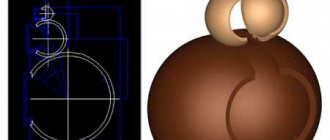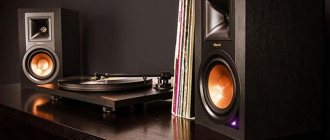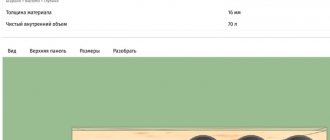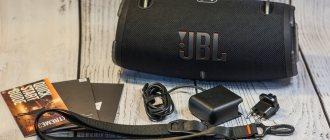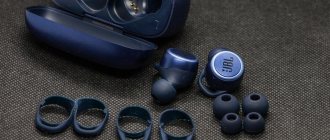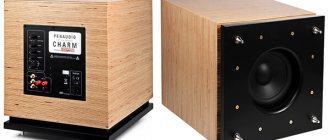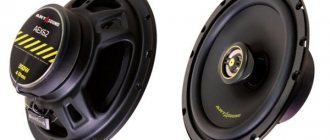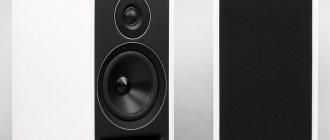According to its characteristics, the 4GD-35 speaker (name according to GOST9010-6773.78) is intended for use in open speakers (acoustic systems) of the first and second complexity groups. It gained well-deserved popularity during the Soviet Union and is still valued by some lovers of good sound. Typically, such heads are installed in TQWT or OYA housings. According to reviews, the 4GD-35 are suitable for listening to live music, for example, jazz, classical works, blues, etc. For playing crazy metal and shirik rock, these speakers are not the best option.
Characteristics
Let's look at the main technical characteristics of the 4GD-35:
- weight – 0.88 kg;
- maximum sound pressure level – 101.0 dB;
- speaker resonance frequency – 65 Hz (maximum deviation from +20% to -15%);
- normalization power – 0.8 W;
- nameplate power – 4 W;
- speaker sensitivity – 92 dB;
- MAX noise power – 8 W;
- maximum long-term electrical power – 8 W;
- operating frequencies of the dynamic head from 63 to 12500 Hz;
- maximum short-term electrical power – 15 W;
- harmonic distortion factor for frequencies: from 1000 to 8000 Hz – 3%;
- from 200 to 300 Hz – 5%;
- 125 Hz – 7%;
The specifications list several different types of power. Let's look at how they differ from each other.
- passport (nominal) - this is the normal mode in which the speaker can operate for a very long time;
- maximum (or maximum) long-term – at such values no more than 1 minute;
- maximum (or maximum) short-term - operating time in this mode is no more than one second.
The magnetic circuit of the 4GD-35 speaker system includes: a magnet made of M16BA ferrite, which has the following dimensions: K75x28x12.5 mm and an upper flange with an internal hole of 21.7 mm. Geometric dimensions of the gap: height 3.9 mm, radial width 0.85 mm. The induction value inside the gap is 0.9 Tesla.
To wind the voice coil, PEVTL wire with a diameter of 0.14 mm was used. Winding is done in two layers. The first layer has 24 turns, the second 21. The winding height is 3.9 mm. CC resistance 3.8 ± 0.9 Ohm. EN-70 grade paper was used as the voice coil frame, which complied with GOST 1931-80. The thickness of the entire frame is 0.14 mm. Overall dimensions of the voice coil: height 16.8 mm, inner diameter 20.3 mm, outer diameter 21 mm. The diffuser has a cone shape and is made of paper.
2-way speakers on two 4 GD-35 and 2 GD-36
For a long time now, 4 pieces of 4GD-35 have been collecting dust in my stash; in fact, they were lying idle and were only being moved from place to place.
Having little experience in using them in SHIELD, I wanted something compact and more or less normal in appearance, otherwise SHIELD is not a very practical thing. Characteristics (single speaker):
Frequency range: 40 (-3 dB) – 15000 Hz
Sensitivity: 93 dB
Resistance: 8 ohms
Power: 16 W
Weight: 25 kg
Since the speakers were with a HUGE, in my opinion* quality factor (about 1.2 - 1.5) and even in the passport the same is written about them. It was decided to make an Open Box, it is essentially the same closed box, only without the back wall, or the same shield but folded back (although there is a difference, in my version it is not critical, the main thing is to grasp the essence and it will be clear further ).
The speakers compare favorably with modern heads with their very high sensitivity - 93 dB, which means that the sound pressure that they are capable of creating with a small input power (nominal 4 W, maximum 8 W, maximum short-term 15 W) is very high.
It also could not help but rejoice that the speakers reproduce the range from 50 to 14000 Hz very well, however, there was a fly in the ointment, and the frequency response curve is really a curve.
Having chosen a couple with a small spread, I inserted them into the TV box, somehow securing them with screws, and sent a signal from the ITUN TDA2050. I was very pleased with the sound. But don’t worry about using them in a cardboard box.
I scraped * along the bottom of the barrel * and molded it, no, not Kolobok, I molded a box from a chipboard board with external dimensions of 410x300x750 mm, the thickness was 16 mm, I made the front wall in two layers, the first was from fragments and the second I strengthened it very well. I covered the inside and outside with carpet and got these columns.
After listening for a couple of days (even before pasting the outside and installing the grills), I began to find fault with the fact that the high frequency was not enough. No sooner said than done, I reached into the stash and took out a couple of car tweeters, nobly picked out from car coaxials. The situation has improved a little, but this *tick* started to *put pressure on my brain*. I took out these rifles and began to look for something like 2GD-36, and was rewarded for this, I found one right away, and a friend brought the second.
Everything would be fine, but tweeters have less sensitivity than broadband speakers, so I started thinking and wondering * who to send where *. In the end, I decided to try connecting the tweeter through a 0.47 uF capacitor without any resistor. I connected it, turned it on and was stunned, in the pleasant sense of the word. The tweeter fit very well into the overall sound and there was no longer a lack of high frequencies.
Having cut out the seat and finally secured the tweeter, I was very pleased with the work done. But, as they say, *it was getting dark*, and since I recently became a family man (in all its joys and well, you understand), the question arose about protecting the speakers from *playful hands*. I went to the store and bought nets.
I think everything is great, I’ll turn it on and listen. But that was not the case, tweeters without grids played very well and did not tire, but with grids they began to put *pressure on the brain*, at first I thought about removing the grills, but still changed my mind, I simply connected a 4 Ohm resistor in series with the HF speaker ( 5 W) and changed the polarity to the tweeter, so my main speakers play in phase, and the tweeters play in antiphase. With this simple *poke method* I got rid of these overtones, and now the squeaker’s life has become easier.
I have broadband speakers with a nominal resistance of 4 ohms each, I connected them in series, and in parallel with them I already connected a tweeter in antiphase.
As a result, we have a speaker with a nominal impedance of 8 Ohms, a more linear frequency response (since the two speakers smooth each other out a little, compensating for dips or surges of one by the other), the overall resonant frequency has decreased to almost 40 Hz. The maximum output power was 16 W with a sensitivity of 93 dB, thus, the sound pressure from these *oldies* is almost the same as from 35 AC-012 with an input power of about 120 W, but in terms of low frequencies they are, of course, unconditionally inferior.
These speakers are most likely best used with a tube amplifier, and many *tube makers* use such speakers in their *projects*, but for me, ITUN on a simple TDA2050 microcircuit is quite enough, which, thanks to this switching circuit, resembles the sound of tube amplifiers, but at the same time introduces much less distortion.
Costs for the entire project:
Can of PVA glue dispersion 1 kg (half a can left): 17 hryvnia
Carpet 2.1 m.p. (width 1.4 m): 155 hryvnia
Grills for speakers + mounts for grills: 84 hryvnia
Travel to the store and back: 4 hryvnia
Self-tapping screws 120 pieces: 12 hryvnia
Speakers and filter capacitors + resistors + wires = were in stock
Time spent on making the cases (clean without smoking breaks for lunch and outdoor recreation): 2 hours
Total: 272 hryvnia
I think *it was worth it*, considering that a *Chinese drone* for that kind of money, standing next to it, will make you smile.
How do they sound? – It’s quite normal, midrange and high frequency are transmitted very well, and low frequency, although not 20 Hz, BUT 40 Hz will easily play back.
If you add a sub or two (one to each speaker and apply an active filter, while connecting bi-amping), then the quality will outshine many mass-produced speakers, with a price tag much higher than the cost of manufacturing my speakers.
Below are a few photos and a video on YouTube demonstrating the work. I’ll immediately warn you that I recorded it with a camera and there’s no point in expecting anything supernatural. I’ll add that in reality *live*, so to speak, the sound is very comfortable and not tiring.
Project author: DTS
The article was prepared for the ldsound . ru
x band speaker on two 4 GD-35 and 2 GD-36
For a long time now, 4 pieces of 4GD-35 have been collecting dust in my stash; in fact, they were lying idle and were only being moved from place to place. Having little experience in using them in SHIELD, I wanted compactness and a more or less normal appearance, otherwise SHIELD is not a very practical thing.
Characteristics (single speaker):
Frequency range: 40 (-3 dB) – 15000 Hz
Sensitivity: 93 dB
Resistance: 8 ohms
Power: 16 W
Weight: 25 kg
Since the speakers were with a HUGE, in my opinion* quality factor (about 1.2 - 1.5) and even in the passport the same is written about them. It was decided to make an Open Box, it is essentially the same closed box, only without the back wall, or the same shield but folded back (although there is a difference, in my version it is not critical, the main thing is to grasp the essence and it will be clear further ).
The speakers compare favorably with modern heads with their very high sensitivity - 93 dB, which means that the sound pressure that they are capable of creating with a small input power (nominal 4 W, maximum 8 W, maximum short-term 15 W) is very high.
It also could not help but rejoice that the speakers reproduce the range from 50 to 14000 Hz very well, however, there was a fly in the ointment, and the frequency response curve is really a curve.
Having chosen a couple with a small spread, I inserted them into the TV box, somehow securing them with screws, and sent a signal from the ITUN TDA2050. I was very pleased with the sound. But don’t worry about using them in a cardboard box.
I scraped * along the bottom of the barrel * and molded it, no, not Kolobok, I molded a box from a chipboard board with external dimensions of 410x300x750 mm, the thickness was 16 mm, I made the front wall in two layers, the first was from fragments and the second I strengthened it very well. I covered the inside and outside with carpet and got these columns.
After listening for a couple of days (even before pasting the outside and installing the grills), I began to find fault with the fact that the high frequency was not enough. No sooner said than done, I reached into the stash and took out a couple of car tweeters, nobly picked out from car coaxials. The situation has improved a little, but this *tick* started to *put pressure on my brain*. I took out these rifles and began to look for something like 2GD-36, and was rewarded for this, I found one right away, and a friend brought the second.
Everything would be fine, but tweeters have less sensitivity than broadband speakers, so I started thinking and wondering * who to send where *. In the end, I decided to try connecting the tweeter through a 0.47 uF capacitor without any resistor. I connected it, turned it on and was stunned, in the pleasant sense of the word. The tweeter fit very well into the overall sound and there was no longer a lack of high frequencies.
Having cut out the seat and finally secured the tweeter, I was very pleased with the work done. But, as they say, *it was getting dark*, and since I recently became a family man (in all its joys and well, you understand), the question arose about protecting the speakers from *playful hands*. I went to the store and bought nets.
I think everything is great, I’ll turn it on and listen. But that was not the case, tweeters without grids played very well and did not tire, but with grids they began to put *pressure on the brain*, at first I thought about removing the grills, but still changed my mind, I simply connected a 4 Ohm resistor in series with the HF speaker ( 5 W) and changed the polarity to the tweeter, so my main speakers play in phase, and the tweeters play in antiphase. With this simple *poke method* I got rid of these overtones, and now the squeaker’s life has become easier.
I have broadband speakers with a nominal resistance of 4 ohms each, I connected them in series, and in parallel with them I already connected a tweeter in antiphase.
As a result, we have a speaker with a nominal impedance of 8 Ohms, a more linear frequency response (since the two speakers smooth each other out a little, compensating for dips or surges of one by the other), the overall resonant frequency has decreased to almost 40 Hz. The maximum output power was 16 W with a sensitivity of 93 dB, thus, the sound pressure from these *oldies* is almost the same as from 35 AC-012 with an input power of about 120 W, but in terms of low frequencies they are, of course, unconditionally inferior.
These speakers are most likely best used with a tube amplifier, and many *tube makers* use such speakers in their *projects*, but for me, ITUN on a simple TDA2050 microcircuit is quite enough, which, thanks to this switching circuit, resembles the sound of tube amplifiers, but at the same time introduces much less distortion.
Costs for the entire project:
Can of PVA glue dispersion 1 kg (half a can left): 17 hryvnia
Carpet 2.1 m.p. (width 1.4 m): 155 hryvnia
Grills for speakers + mounts for grills: 84 hryvnia
Travel to the store and back: 4 hryvnia
Self-tapping screws 120 pieces: 12 hryvnia
Speakers and filter capacitors + resistors + wires = were in stock
Time spent on making the cases (clean without smoking breaks for lunch and outdoor recreation): 2 hours
Total: 272 hryvnia
I think *it was worth it*, considering that a *Chinese drone* for that kind of money, standing next to it, will make you smile.
How do they sound? — It’s quite normal, midrange and high frequency are transmitted very well, and low frequency, although not 20 Hz, BUT 40 Hz will easily play back.
If you add a sub or two (one to each speaker and apply an active filter, while connecting bi-amping), then the quality will outshine many mass-produced speakers, with a price tag much higher than the cost of manufacturing my speakers.
Below are a few photos and a video on YouTube demonstrating the work. I’ll immediately warn you that I recorded it with a camera and there’s no point in expecting anything supernatural. I’ll add that in reality *live*, so to speak, the sound is very comfortable and not tiring.
